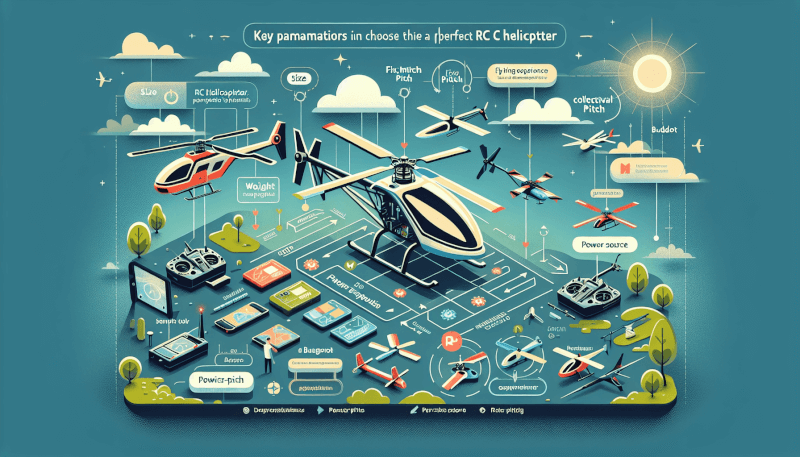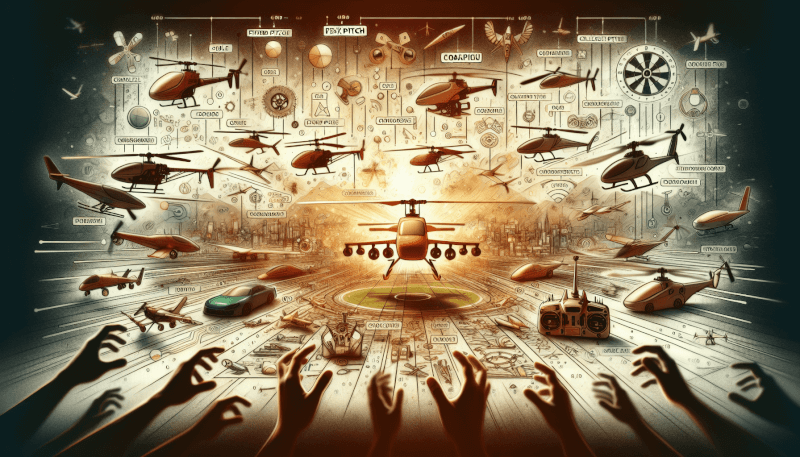Are you looking to take your love for remote-controlled helicopters to the next level? In this article, we will provide you with valuable tips on how to choose the right RC helicopter for your needs. With so many options available in the market, it can be overwhelming to decide which one is the best fit for you. Whether you are a beginner or a seasoned enthusiast, these tips will guide you in making an informed decision, ensuring hours of thrilling and enjoyable flights.

Consider your skill level
When choosing an RC helicopter, it’s important to consider your skill level as a pilot. This will help you determine which type of helicopter is best suited for you.
Beginner
If you’re new to flying RC helicopters, it’s recommended to start with a beginner-level model. These helicopters are typically easier to fly and have simpler controls, making them perfect for those who are just starting out. They often have built-in features such as gyro stabilization and auto-leveling, which help to stabilize the helicopter and make it easier to control.
Intermediate
If you have some experience flying RC helicopters and are looking to step up your game, an intermediate-level helicopter may be the right choice for you. These helicopters are a step up from beginner models, offering more advanced features and controls. They usually have a higher level of customization and allow for more advanced maneuvers and tricks.
Advanced
For experienced pilots who are looking for a challenge, advanced-level RC helicopters are the way to go. These helicopters are highly customizable and offer a wide range of options for fine-tuning the controls and performance. They often have more powerful motors and can reach higher speeds and perform more complex maneuvers. However, they require a higher level of skill and expertise to fly, so they are not recommended for beginners or those with limited flying experience.
Decide on the type of RC helicopter
Once you have determined your skill level, it’s time to decide on the type of RC helicopter that suits your needs and preferences.
Coaxial
Coaxial helicopters are a great choice for beginners and those who are looking for a stable and easy-to-fly option. They have two sets of rotors that rotate in opposite directions, providing increased stability and eliminating the need for a tail rotor. This design makes them easier to control and hover in one place, which is ideal for beginners who are still learning the basics of flying.
Fixed Pitch
Fixed pitch helicopters are a popular choice among intermediate level pilots. They have a single main rotor and a fixed pitch rotor blade, which means the pitch of the rotor blade does not change during flight. This allows for more maneuverability and control, making them suitable for more advanced flying techniques such as flips and rolls.
Collective Pitch
Collective pitch helicopters are the most advanced and versatile type of RC helicopter. They have a variable pitch rotor blade, which means the pitch can be adjusted during flight. This allows for precise control and the ability to perform advanced maneuvers such as inverted flight and 3D aerobatics. They are highly maneuverable and require a high level of skill to fly, making them best suited for experienced pilots.
Evaluate the size of the helicopter
The size of the RC helicopter you choose will depend on various factors such as your flying environment, preference, and skill level.
Micro
Micro helicopters are the smallest and lightest option available. They are typically around 6-8 inches in length and are designed to be flown indoors or in small outdoor spaces. They are great for beginners and for practicing flying skills in a confined area. However, due to their small size, they are more susceptible to wind and can be more challenging to control in outdoor environments.
Mini
Mini helicopters are slightly larger than micro helicopters, typically ranging from 10-14 inches in length. They can be flown both indoors and outdoors and offer a good balance between stability and maneuverability. They are suitable for intermediate pilots who have some experience flying RC helicopters and are looking for a more versatile option.
Full-size
Full-size RC helicopters are the largest and most powerful option available. They are typically around 24-30 inches in length and are capable of flying in larger outdoor areas. They offer the highest level of stability and control, making them ideal for advanced pilots who are looking to perform complex maneuvers and tricks. However, due to their size and power, they can be more expensive and require more maintenance.
Check the flight time and battery life
When choosing an RC helicopter, it’s important to consider the flight time and battery life. These factors will determine how long you can fly before needing to recharge or replace the batteries.
Flight time
The flight time refers to the duration for which the helicopter can stay in the air on a single battery charge. This can vary depending on the size and type of helicopter, as well as the battery capacity. Beginner and intermediate-level helicopters typically have flight times ranging from 5-10 minutes, while advanced-level helicopters can have flight times of 15 minutes or more. It’s important to consider your flying preferences and needs when deciding on the desired flight time.
Charging time
The charging time refers to the duration it takes to fully charge the helicopter’s battery. This can vary depending on the charger used and the battery capacity. It’s important to consider the charging time when planning your flying sessions, as longer charging times can limit the amount of time you can spend flying. Some helicopters may also offer the option to purchase separate fast chargers, which can significantly reduce the charging time.
Spare batteries
Having spare batteries is essential if you want to extend your flying time without having to wait for the batteries to recharge. It’s always a good idea to have at least one or two spare batteries on hand, especially if you plan to have long flying sessions or if you’re going to be flying in areas where you may not have access to a power source. Make sure to check if the helicopter you’re considering has easily accessible and affordable spare batteries available.

Assess the range and frequency
The range and frequency of an RC helicopter are important factors to consider, as they will determine how far you can fly the helicopter and how susceptible it is to interference.
Control range
The control range refers to the maximum distance at which you can control the helicopter using the transmitter. This can vary depending on the type of helicopter and the transmitter used. Beginner and intermediate-level helicopters typically have control ranges of around 100-300 feet, while advanced-level helicopters can have control ranges of up to 1000 feet or more. It’s important to consider your flying environment and preferences when determining the desired control range.
Interference frequency
Interference frequency refers to the radio frequency at which the helicopter operates. It’s important to choose a frequency that is not heavily congested with other devices, as this can result in signal interference and loss of control. Most RC helicopters operate on either 2.4GHz or 5.8GHz frequencies, which are widely used and offer good signal stability. Some helicopters may also offer the option to switch between different frequencies or channels to further minimize interference.
Consider the helicopter’s durability
Durability is an important factor to consider, especially if you’re a beginner or if you plan to fly in outdoor areas where the helicopter is more susceptible to crashes and accidents.
Build material
The build material of the helicopter plays a significant role in its durability. Common materials used for RC helicopters include plastic, carbon fiber, and metal. Plastic helicopters are generally more lightweight and less prone to damage from crashes, making them a good choice for beginners. Carbon fiber and metal helicopters offer increased durability and resistance to crashes but can be more expensive. Consider your flying environment and flying style when deciding on the desired build material.
Crash resistance
The crash resistance of an RC helicopter refers to its ability to withstand crashes and accidents without sustaining significant damage. Beginner and intermediate-level helicopters typically have more built-in crash resistance features such as rotor guards and landing skids, which help protect the helicopter’s delicate components. Advanced-level helicopters may have fewer crash resistance features but offer higher build quality and more robust components. It’s important to find a balance between crash resistance and performance based on your skill level and flying style.

Look for stability features
Stability features are essential for beginners and can also benefit intermediate and advanced pilots by providing a smoother and more controlled flying experience.
Gyro stabilization
Gyro stabilization is a common feature found in RC helicopters that helps to stabilize the helicopter during flight. It works by automatically adjusting the rotor blades’ pitch and speed to counteract any unwanted movements or instability. This feature is especially useful for beginners as it helps to keep the helicopter level and prevents it from tipping over or spinning out of control. Some helicopters may also offer adjustable gyro settings, allowing you to fine-tune the stability based on your flying preferences.
Auto-leveling
Auto-leveling is another stability feature that is commonly found in beginner and intermediate-level helicopters. It works by automatically leveling the helicopter when the controls are released, ensuring that it returns to a stable hover position. This feature is particularly useful for beginners who may struggle with maintaining a steady hover or for pilots who are learning more advanced maneuvers. Auto-leveling can provide an added safety net and help prevent crashes and accidents.
Research the controller options
The controller you use to fly your RC helicopter is just as important as the helicopter itself. Different controllers offer different features and control options, so it’s essential to choose one that suits your needs and preferences.
Transmitter type
There are two main types of transmitters used for RC helicopters: stick transmitters and gamepad-style transmitters. Stick transmitters have a more traditional design with two control sticks and offer more precise control. Gamepad-style transmitters, on the other hand, have a more familiar layout for gamers and may have additional features such as LCD screens and programmable buttons. It’s important to choose a transmitter type that feels comfortable in your hands and offers the control options you desire.
Channels
The number of channels on a transmitter determines the number of independent control functions it can handle. Beginners typically start with 3-channel or 4-channel helicopters, which provide basic control over throttle, yaw, pitch, and roll. Intermediate and advanced pilots may opt for helicopters with 6 or more channels, which allow for more advanced control functions such as adjustable gyro settings and collective pitch control. Make sure to choose a transmitter with the appropriate number of channels for the helicopter you’re considering.

Review customer reviews and ratings
One of the best ways to gather information about an RC helicopter is to read customer reviews and ratings. These reviews provide valuable insights into the performance, durability, and overall satisfaction of other pilots who have purchased and flown the helicopter.
Online reviews
There are numerous online platforms and forums where you can find reviews and discussions about RC helicopters. Look for reviews from pilots who have a similar skill level and flying preferences as you to get a better idea of how the helicopter will perform for you. Pay attention to any recurring issues or complaints mentioned in the reviews, as these may indicate potential problems with the helicopter.
Product ratings
Product ratings can provide a quick and easy way to gauge the overall satisfaction of customers who have purchased a particular helicopter. Keep in mind that ratings may vary depending on individual preferences and experiences, so it’s important to read the accompanying reviews to get a more detailed understanding of the helicopter’s pros and cons.
Set a budget
Setting a budget is an important step in choosing the right RC helicopter. RC helicopters can vary significantly in price, depending on factors such as size, type, features, and brand.
Pricing options
RC helicopters can range from affordable options that are suitable for beginners to high-end models that offer advanced features and performance. Determine your budget based on your financial situation and how much you are willing to invest in your RC hobby. It’s important to find a balance between price and quality, ensuring that you get a helicopter that meets your needs without overspending.
Additional costs
In addition to the initial purchase price of the helicopter, it’s important to consider any additional costs that may be associated with owning and flying an RC helicopter. These can include spare batteries, replacement parts, tools, and accessories such as carrying cases or upgrades. Make sure to factor in these costs when setting your budget to avoid any surprises down the line.
By considering your skill level, the type and size of the helicopter, flight time and battery life, range and frequency, durability, stability features, controller options, customer reviews and ratings, and budget, you can make an informed decision and choose the right RC helicopter that will provide you with hours of enjoyment and flying fun. Happy flying!



